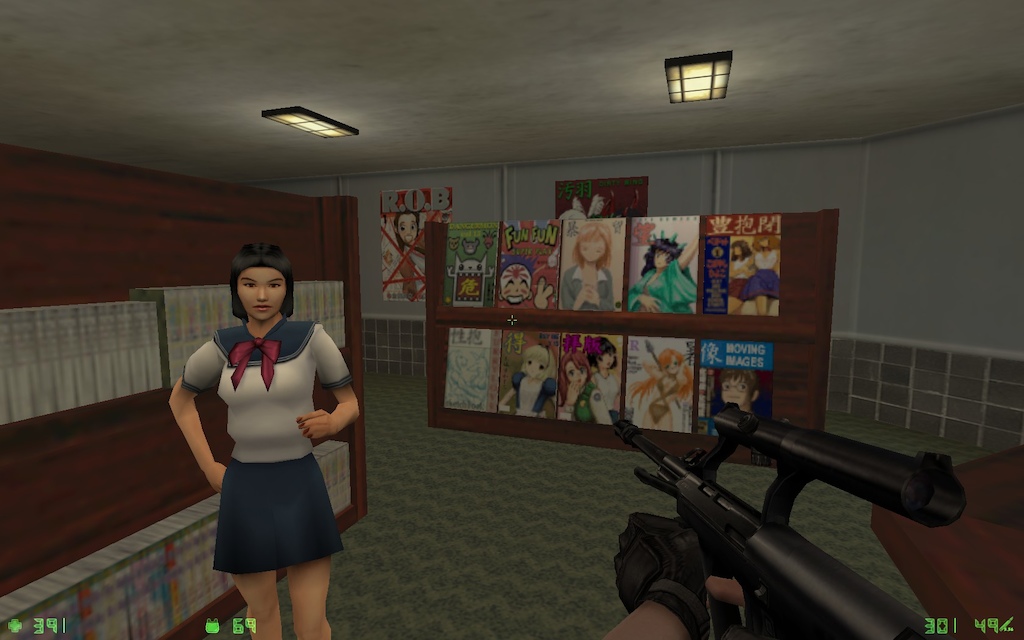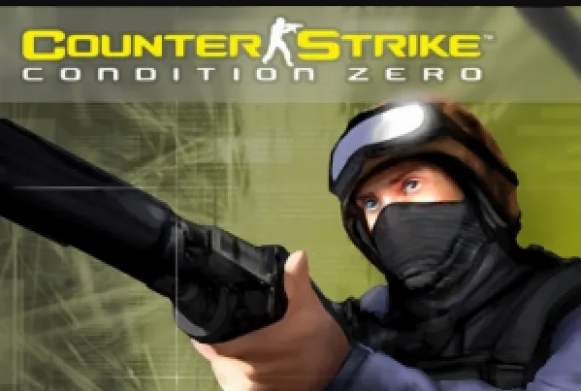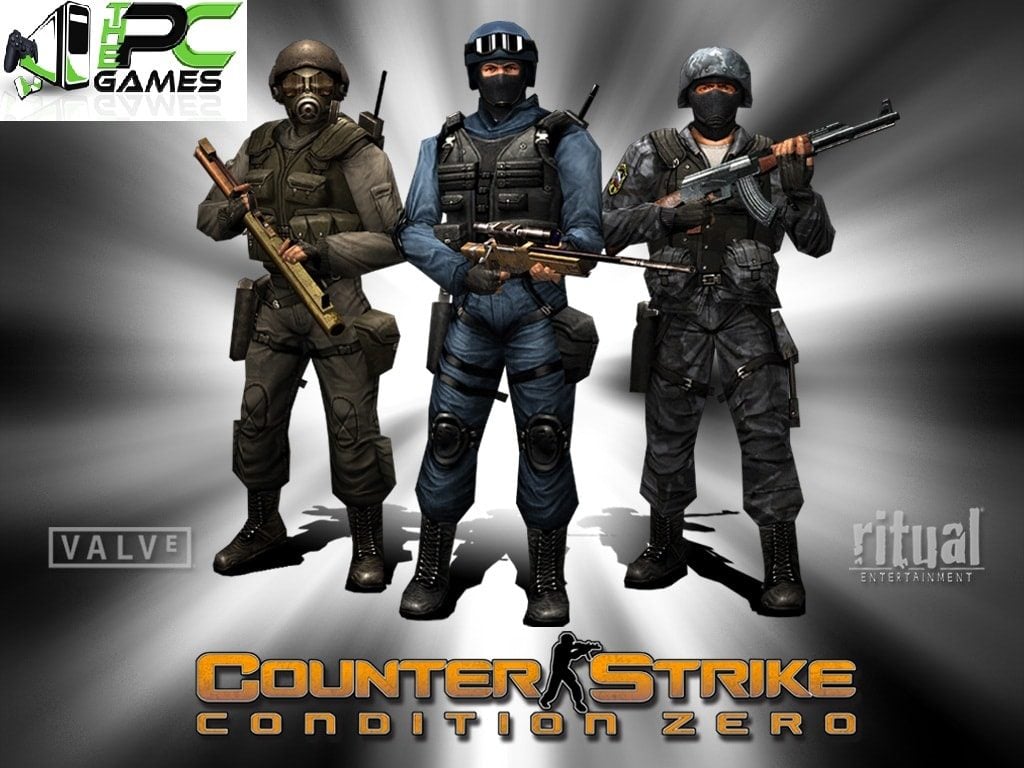At B.3 OAM on a winter’s day, Paris isn’t quite so gay. Waking from three hours of restless, alcohol-fuelled sleep, to find a comatose Steve Hill less than a foot away in an adjacent bed, rasping like an overheating electric saw, glasses precariously hanging off one ear in a pool of his own drool - only makes it worse. But while spirits may have been creaking like a cheap hotel bed, hopes within our party of 15 dishevelled UK journalists were high, as we were transported in a rickety coach - portaloo already brimming with four types of human excretion from the previous day’s cross-Channel journey - to our destination, an aristocratically eccentric chateau which was to host the annual VU Games press show.
Mar 02, 2020 Counter-Strike has always been one of the most loved battle games. It’s sequel CS Condition Zero is an excellent addition to the franchise. The premise of Condition Zero, the round-based game, is the same as the original and consists of two teams that compete against each other. Due 16 months ago (when it was still being developed by Gearbox), Condition Zero claims to be the single-player version of Counter-Strike, the world's favourite online shooter. Which (obviously) means, you don't need to go online to play it.
After four and a half hours, we arrived at the grandiose building, and were promptly ushered out of the vehicle by clucking Frenchmen towards the galleries housing a host of VU Games developers demonstrating their wares to the press. Throngs of pallid, under-nourished journos shunted their way from one room to the next as Hill and I peeled off in opposite directions. We had work to do. My mission - to track down legendary developer Randy Pitchford, who, it was rumoured, was as big as a giant and had a rocket launcher for an arm.
Seeing Is Believing
Visibility was down to a minimum as I eked my way through swathes of bodies, matted together with sweat and spilt coffee towards the Gearbox stand showing Counter-Strike: Condition Zero, the single-player version of the greatest online shooter of our time. Suddenly it appeared, looming from the greyness like a beacon to the lost, drawing in slack-jawed observers like fireflies to a lantern. Standing in front of me, was the man himself, Mr Randy Pitchford, not a bazooka-toting behemoth, but an affable enthusiastic man. speaking to a pair of buck-toothed Ren and Stimpey lookalikes.
I watched for a while as a manic bot-filled firefight kicked off on one of CZ’s impressive-looking new levels, where shards of debris flew off every surface as mis-aimed bullets thudded into walls. During a lull in the action, I took the opportunity to ask how you, as the commander of your team of special forces soldiers, would be able to interact with your comrades.
'When we started work on Condition Zero, we found that there were two approaches to solving the problem of a command interface. The first of these is getting your team to do what you want. Developing this kind of FPS is no longer about being alone in the world - it’s about developing a team-based singleplayer game and making the Al believable, plausible and fun. One of the key problems is making sure the guys don’t look like idiots, and doing what you want them to. Basically they should be enhancing your experience of the game, not counteracting it,' explained Randy chirpily. Like a newborn I wedged myself between the two animated hunks of flesh that stood either side of me to get a better view. Things were beginning to get interesting.
A Tale Of Two Interfaces
Randy was now in an ebullient mood so I thrust my Dictaphone nearer to his face to record his every word. 'We’ve actually used two interfaces instead of one.
For the first one, we’ve developed a complicated system which allows you to directly give orders to your teammates, such as getting one bot to take point. We decided it was important that we give the player some direct control over what their team-mates do. Once the mission starts, it’s chaos, and both human and computer-controlled players will care primarily about survival and their objective. So a lot of the time, the bots will be making their own decisions about what’s going to keep them alive and what’s going to get the job done. However, as you’re the squad leader, sometimes you’ll have to make the all-important decisions and that’s where the direct command system comes in.'
And what about the second approach to interacting with your team-mates? 'The other approach to solving the problem is to get the Al to take a look at both what the player and the other Al characters are doing, as well as the way the map is built, and from this figure out what the smartest decisions are. An example of this is walking into an open area where there is potential to be sniped. So the first bot will go to a certain point and cover the next guy as he makes his way to the same spot, so that the whole group moves together like a real military unit.' Coo.He wasn’t wrong either. Gesturing for me to have a go, I clutched the controls in tepid palms.
cocksure that my years of office Counter-Strike sessions would put me in good stead for the trials ahead. Twenty seconds later, I was dead, decapitated by a well placed LAW rocket. Eager to make amends I tried again, attempting to outflank the enemy with my squad of three highly trained soldiers. It was then I noticed it. The bots in CZ aren’t some mookish collection of pre-defined brainwashed drones, conforming to a set of poorly comprised Al routines and scripts. No-no-no-no-no! These bots are very different. Lifelike some might say. They worked together in a well-organised team, opting for differing routes depending on their past experiences. These are written to a file which tells them what kind of things happened when they played before, negating any chance of predictability and on this occasion, scuppering my feeble and poorly thought out plans for an ambush.
Tours Of Duty
Randy then informed me that hardened Counter-Strike veterans will be in for a stern test, while partially solidified FPS players will find even some of the earlier levels, seriously challenging. 'When playing against the bots, many hardened CS players who've been testing the game haven’t been able to tell the difference between them and human players,' bragged Randy. The man wasn’t talking crap either, as he and his Bot mates proved by battling frantically to extinguish an enemy stronghold. Such was the tension, in fact, that while we watched the action unfold, the Stimpy lookalike started shaking uncontrollably with excitement, buck teeth knocking violently against his kneecaps, dislodging pieces of his lunch and sending them arching off in random directions as he trembled. Picking out a piece of cold fish which had lodged itself in my ear, I asked Randy to tell us a bit about the new types of missions, and some of the new mission goals we could expect to see in CZ.
'We’ve put in many new objectives in each mission, alongside old ones like defusing bombs. These new goals may involve getting your whole squad from one side of the map to the other without losing a single man. So you have to start thinking about how to play each level differently. In this case you may send one man out as a decoy, while the rest of you take another path.' As if to confirm this, Randy set about stealthily negotiating a derelict-looking level, full of decrepit crumbling buildings, sending off a sniper to distract the advancing terrorist scum -some armed with riot shields, others with Molotov Cocktails - while he and the rest of the team headed off in the opposite direction. Once the level was complete a wry smile tinted with smugness crossed his face for the briefest of moments before composure returned and the demonstration continued.
'We started thinking about the way most people use the same weapon every time. So another objective may be trying to complete a mission where every member of the team is forced to use the same weapon. This throws up a totally different tactical situation. In any given mission there are nine objectives and each of these is divided into modes. The narrative mode will involve the classic types of mission goals such as defusing a bomb, rescuing hostages and planting surveillance equipment. Then there’s the challenge mode, where you may have to get five kills using just the shield and the pistol. This means you’ll have to get very skilled with a handgun. If you achieve this you’ll get more money for the next mission, meaning you can recruit more guys, train the ones you already have and purchase heavier weaponry. Certain soldiers specialise in certain skills, so someone with a high accuracy potential will be worth investing in as he has the potential to become an incredible sniper.'

I Hear You
Suddenly a high-pitched squeal cut its way through my ear drums, emanating from the back of the rabble of journos which had, unbeknown to me, converged on the CZ stand, behind which stood the other developers, vacant, confused and unsure of what to do next while everyone ignored them. 'Tell me vich new aaarierth offf combat zer vill be in game?' came the cry. What? Fortunately Randy understood. 'There are six regions. South American jungles with drug lords, the Middle East with loads of terrorist missions, urban European, the Far East, Arctic regions of Russia and the United States. Each territory will have three or four missions. In each one there are nine different objectives. So overall, there are about 200 mission goals in the whole game. Newcomers will be taken care of with an in-depth tutorial.' Not bad, we all agreed, nodding sagely at one another now in a kind of brainwashed union, assimilating every word Randy spoke and marvelling at the game before us. But Randy, undeterred by the bobbing heads, was intent on pushing on. Happily and in a hushed silence we let him continue, watching as he brought up the intuitive new menu system and demonstrating the ease with which you’ll be able to buy new weaponry and train your team.
'When you start the game you’ll only have a little bit of money, so the first few missions will be solo affairs, probably armed with some kind of pistol. As you start making money though, you can recruit guys to join your team and buy yourself better weapons.'

'And what of the bots? What skills will they have?' I enquired, voice resounding like a bomb through the room. 'Glad you mentioned that actually, great question.' Smug grin from Martin. Moans of hatred from everyone else. 'There are ten skills, five of which are exposed for training,which include small arms, demolitions, rifles, tactics awareness. This one is their ability to ct to the sounds that they hear, such as knowing what weapons are being fired at them. Knowing things like this will affect their behaviour. It’s a bit like combat experience. The tactics skill represents their ability to communicate with each other and move together as a unit.' Glancing at my watch it became apparent I had stayed too long. I’d seen what I’d come to see and heard what I’d hoped I’d hear. Condition Zero was looking little short of stunning, with an engine so brilliantly enhanced that it was barely discernable from the original Half-Life one. As I pushed my way through the rabble, I threw a cursory and somewhat sympathetic glance to the man at the Nascar2002 stand, isolated and ignored bar one suited man who stood like a wax figurine, holding a gaming wheel steady at a slight leftwards i angle. The verdict was clear.
No game on show that day could come close to competing, and as I clambered back on the bus. I realised that any team-based first-person W shooter out this year would have trouble doing so too. B And I couldn’t help but smile at the knowledge that ZONE would be running the exclusive review of Condition Zero next issue, and Br the exclusive demo the issue after.
And so another press trip was over, ending the way each one does. with a three-hour trip to a pub and a coachload of bedraggled, sweating, balding men without proper jobs, falling into a coma as they waited for their nextgaming, alcoholic, or as it turned out on k this occasion, pornographic hit. Well, this was Paris after all...
Paid first-person shooting game
Counter-Strike: Condition Zero is a first-person shooting game developed by Valve. This sequel game’s release was long-awaited by fans around the world!

Old is gold, and Counter-Strike is no different
Counter-Strike: Condition Zero is the first-person shooter game made by Ritual Entertainment, Valve, Sierra Entertainment, and many other studios. It was the original follow-up to the infamously popular game Counter-Strike that struck a chord with fans everywhere. Released for Windows in 2004, the game features online and offline modes, as well as multiple ways to play.
However, not all that glitters is actually gold
The game has received mixed reviews. While Counter-Strike: Condition Zero was an improvement in the series, the game faced more problems than it initially solved. The graphical updates remained a plus for players while the online play was a separate problem. Additionally, the offline modes only remained a lackluster change to the game as a whole. Players found themselves frustrated with the bot presence in the online mode, and even worse, to go to an offline mode that was boring in comparison.
Old problems that outweigh old solutions
As a whole, Condition Zero remained on par with the previous title. Despite its improvements over its predecessor, the delay in production (nearly 2 years after the deadline) failed to compensate for the overwhelming problems it proved to have upon release. The game was praised for its AI, but condemned for feeling outdated despite extra production time and failing to solve the problems it so blatantly had with new and old features.
Our take

Counter-Strike: Condition Zero remains an improvement on the original Counter-Strike, regardless of its mixed reviews. Despite everything that the game is lacking, it remains a steady improvement and a must-play for any fan of the original title.
Should you download it?
Yes, this piece of gaming history is a bargain. While it is not up to snuff with other contenders such as Halo 4 or Earth Defense Force 2025, CS: Condition Zero is still a landmark in the gaming world, having broken new ground in terms of AI and map creation.
Highs
- An old repolish of a great game.
- Intuitive AI for its day.
- Maps that are well designed.
- Online multiplayer with server creation.
Counter-strike Condition Zero Cd-key
Lows
Counter Strike Condition Zero Deleted Scenes
- Game harshly criticized as being unfinished despite pushing deadlines.
- Not very different from the original title in terms of extra content.
- Many bundles available on Steam ask for a high price in total.
- Did not age gracefully.
- Offline modes that were painstakingly made past development deadline.

Counter-Strike: Condition Zerofor Windows
Counter-strike 1.6
1.0